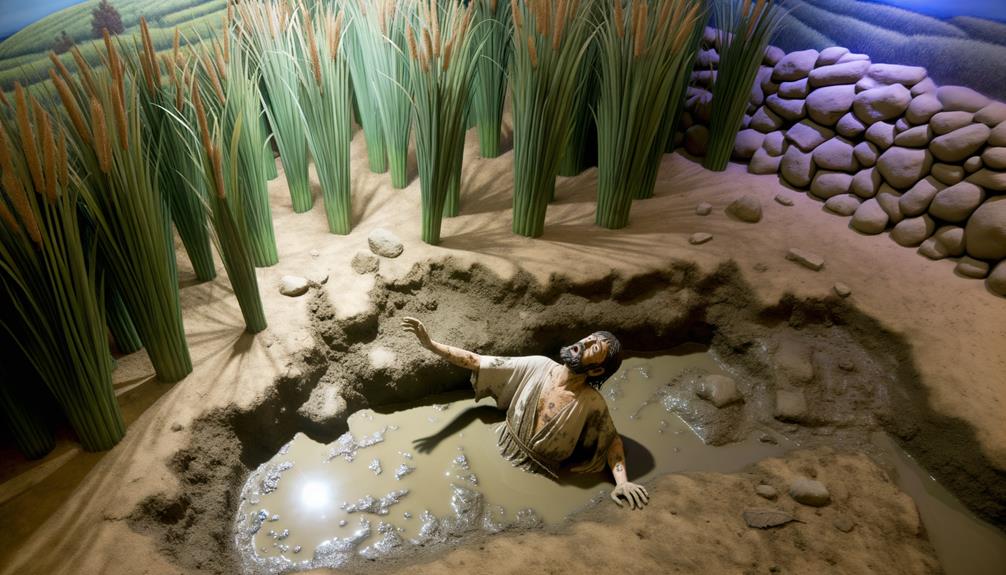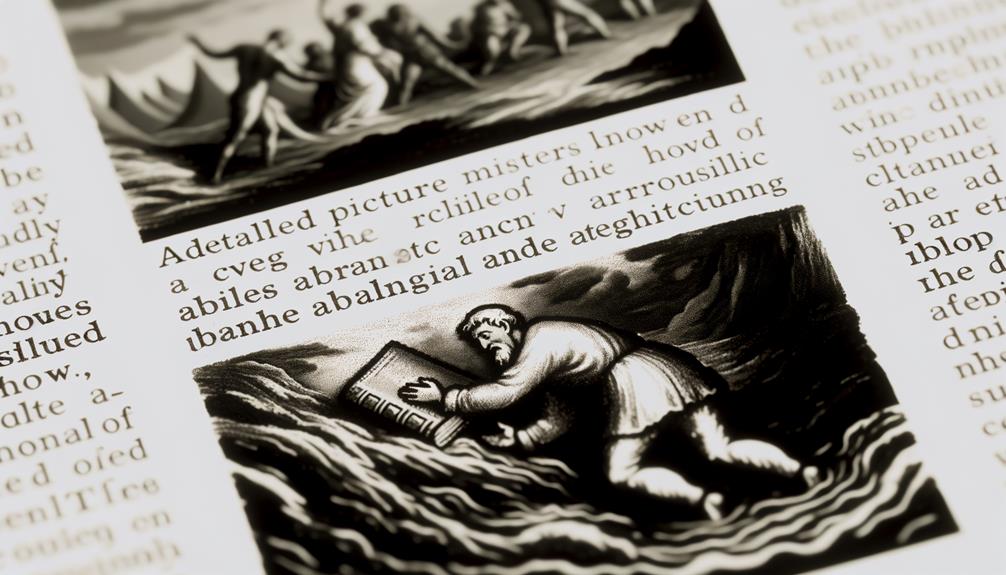Mire Meaning in the Bible: Symbol of Despair
In biblical literature, ‘mire’ represents a powerful metaphor for moral degradation, spiritual entrapment, and the far-reaching impacts of sin. It frequently appears in the Old and New Scriptures, illustrating the bleak consequences of ethical deviation and the ensnaring nature of sin (e.g., Jeremiah 38:6; 2 Peter 2:22).
This term underscores the contrast between divine purity and human disobedience while highlighting the urgent need for redemption. The imagery of mire mirrors the struggle of escaping moral corruption, thereby emphasizing mankind’s vulnerability to moral failings.
For a more thorough understanding of this symbolic term, explore its scriptural usage and implications.

Mire Meaning in the Bible: Symbol of Sin, Struggle, and Redemption
| Aspect | Details |
|---|---|
| Definition | Muddy or swampy ground; figuratively represents sin, trouble, or corruption |
| Biblical References | Psalm 40:2, Jeremiah 38:6, 2 Peter 2:22 |
| Symbolism | Represents moral filth, entrapment, and spiritual downfall |
| Used Figuratively | To describe those who return to sin or feel stuck in spiritual despair |
| Spiritual Lesson | Emphasizes God’s power to lift us from sin and restore us to righteousness |
Definition of Mire

In biblical literature, the term ‘mire’ typically refers to a boggy or swampy ground, symbolizing a state of degradation, entrapment, or moral filth. This imagery is employed to convey the spiritual and ethical decay that individuals or societies may experience when they stray from divine principles.
The concept of mire underscores the difficulty of extricating oneself from sinful or corrupt conditions once ensnared. It serves as a powerful metaphor to illustrate the consequences of moral lapse and the entangling nature of sin.
The term’s usage in biblical texts often highlights the contrast between the purity of divine guidance and the sullied state of human disobedience, emphasizing the necessity of redemption and spiritual cleansing.
Mire in the Old Testament

The concept of mire is vividly illustrated in the Old Scripture through various passages that depict the physical and spiritual perils associated with moral corruption and disobedience to God.
For instance, in Jeremiah 38:6, the prophet Jeremiah is cast into a cistern filled with mire, symbolizing the degradation and danger faced by those who defy divine commandments.
Similarly, Psalm 69:2 portrays the psalmist sinking in deep mire, a metaphor for overwhelming distress and the consequences of sin.
The imagery of mire in these texts serves as a potent symbol of the entanglement and ruin that moral failings can bring upon individuals, emphasizing the need for righteousness and adherence to God’s laws. Consequently, mire encapsulates the peril of spiritual defilement.
Mire in the New Testament

In the New Scriptures, the concept of mire is frequently employed metaphorically to illustrate the entangling nature of sin and moral decay. This symbolism carries substantial spiritual implications, particularly in emphasizing the need for redemption and the dangers of returning to former sinful behaviors.
Additionally, parables involving mire often serve as cautionary tales, underscoring the importance of steadfast faith and moral vigilance.
Metaphorical Uses of Mire
Mire serves as a potent metaphor in the New Covenant, often symbolizing the entanglement and degradation of sin. This imagery underscores the moral and spiritual decay that results from straying from divine principles.
In the New Scriptures, mire is employed to illustrate the following thematic elements:
- Moral Corruption: Highlighting the debasing impact of sinful behavior.
- Spiritual Entrapment: Reflecting the difficulty of escaping once ensnared.
- Human Frailty: Emphasizing mankind’s susceptibility to moral failures.
This metaphorical usage effectively conveys the profound consequences of sin, providing a vivid representation of the struggles faced by believers in their spiritual journey.
The imagery of mire illustrates the need for divine intervention and the hope for spiritual cleansing.
Spiritual Implications of Mire
Throughout the New Scripture, references to mire serve as profound illustrations of the pervasive and entangling nature of sin, urging believers to seek spiritual purification and divine guidance.
The New Covenant employs the imagery of mire to depict the soul’s entrapment in moral degradation and spiritual confusion. For instance, 2 Peter 2:22 likens those who return to sinful behaviors to a sow wallowing in the mire, underscoring the futility and despair of a life unredeemed.
This metaphor is not merely a call to recognize sin but also an exhortation to pursue holiness through Christ. Therefore, the New Covenant’s use of mire is a compelling reminder of the transformative power of faith and the necessity of spiritual vigilance.
Parables Involving Mire
Several parables in the New Scriptures incorporate the imagery of mire to illustrate the consequences of moral failure and the imperative of spiritual redemption. This metaphor underscores the depth of human sin and the entangling nature of transgression, emphasizing the necessity for divine intervention.
- Parable of the Prodigal Son: The prodigal’s degradation can be likened to mire, signifying his moral descent.
- Parable of the Lost Sheep: The straying sheep represents a soul trapped in mire, needing rescue.
- Parable of the Sower: Seeds falling among thorns can symbolize mire, indicating hindered spiritual growth.
Such parables reveal the transformative power of redemption over the mire of sin.
Symbolism of Mire

In biblical literature, mire often symbolizes the entanglement and degradation associated with sin and moral corruption. This imagery is poignantly illustrated in passages such as Psalm 40:2 and Jeremiah 38:6, where the mire represents a state of despair and helplessness from which only divine intervention can deliver.
The visual of being stuck in mire conveys the profound difficulty of extricating oneself from sinful behaviors and the moral decay they engender. Additionally, the mire’s association with uncleanliness and impurity further underscores its symbolic role in depicting the moral and spiritual quagmire of sin.
Consequently, the biblical use of mire effectively communicates the gravity and entrapment of moral failings, highlighting the need for redemption and purification.
Spiritual Implications

The symbolic representation of mire in biblical texts extends beyond its portrayal of sin to encompass profound spiritual implications that shape the understanding of human redemption and divine intervention.
The imagery of mire often serves as a metaphor for the spiritual entanglements that hinder one’s relationship with God. It highlights the necessity of divine grace for spiritual liberation and sanctification.
- Redemption: Being lifted from mire symbolizes God’s redemptive power to rescue believers from spiritual despair.
- Divine Intervention: It underscores the indispensability of divine intervention in overcoming spiritual obstacles.
- Transformation: The process of being cleansed from mire reflects spiritual renewal and transformation.
This perspective enriches the theological discourse on human frailty and divine mercy.
Moral Stagnation

Moral stagnation, often depicted through the metaphor of mire in biblical literature, signifies the state of spiritual inertia where individuals remain entrenched in sinful behaviors and attitudes. This notion underscores a debilitating cycle of ethical paralysis, preventing progress towards a more virtuous life.
The mire symbolizes a quagmire of poor moral choices and resistance to spiritual growth, trapping individuals in a state of perpetual degradation. This metaphor emphasizes the peril of neglecting moral and ethical responsibilities, leading to a life devoid of spiritual fulfillment.
Biblical texts use this imagery to caution believers about the consequences of moral complacency and to advocate for continuous self-examination and repentance as pathways to spiritual rejuvenation and moral elevation.
Examples of Mire

Biblical literature provides numerous vivid illustrations of individuals and communities ensnared in moral mire, highlighting the spiritual and ethical consequences of such entrapment. These examples serve as potent reminders of the perils associated with straying from divine principles.
- King David’s Adultery: His affair with Bathsheba and the subsequent murder of Uriah exemplify moral degradation.
- Israel’s Idolatry: The worship of the golden calf at Mount Sinai signifies collective spiritual decline.
- Judas Iscariot’s Betrayal: His treachery against Jesus illustrates profound personal corruption.
These narratives underscore the Bible’s emphasis on the severe repercussions of ethical and spiritual lapses, serving as cautionary tales for believers.
Lessons From Mire

Analyzing the recurring theme of moral entanglement in biblical narratives reveals profound insights into the consequences of ethical deviations and the paths to spiritual redemption.
The metaphor of mire, often depicted as a quagmire or pit, symbolizes the debilitating nature of sin and moral compromise. Characters ensnared in mire, such as Jeremiah in the cistern (Jeremiah 38:6), illustrate the stagnation and peril of straying from divine principles.
These stories emphasize the inherent dangers of ethical lapses, urging adherence to virtuous living. Furthermore, the mire serves as a stark reminder of the importance of maintaining spiritual vigilance and integrity.
The recurring motif underscores the Bible’s broader moral teachings, advocating for a life aligned with divine will to avoid the metaphorical mire.
Pathways to Redemption

In exploring pathways to redemption, the Bible provides a multifaceted framework for understanding how individuals can extricate themselves from the mire of sin and renew their spiritual journey. This redemptive process is intricately woven through various biblical narratives and teachings, emphasizing the importance of repentance, faith, and divine grace.
Key elements include:
- Repentance: Sincere acknowledgment of one’s sins and a commitment to turn away from them.
- Faith in Christ: Trusting in Jesus Christ’s sacrificial death and resurrection as the foundation for redemption.
- Obedience: Adhering to God’s commandments and seeking to live a life that aligns with His will.
These elements collectively guide believers towards spiritual restoration and renewal.
Conclusion
The biblical concept of mire extends beyond physical mud to represent spiritual and moral stagnation.
For instance, the story of Jeremiah being cast into the cistern (Jeremiah 38:6) symbolizes the dire consequences of ignoring divine instruction, illustrating how one can become ensnared in a quagmire of sin and despair.
Understanding the symbolism and implications of mire encourages believers to seek pathways to redemption, emphasizing the necessity of spiritual vigilance and moral integrity.






